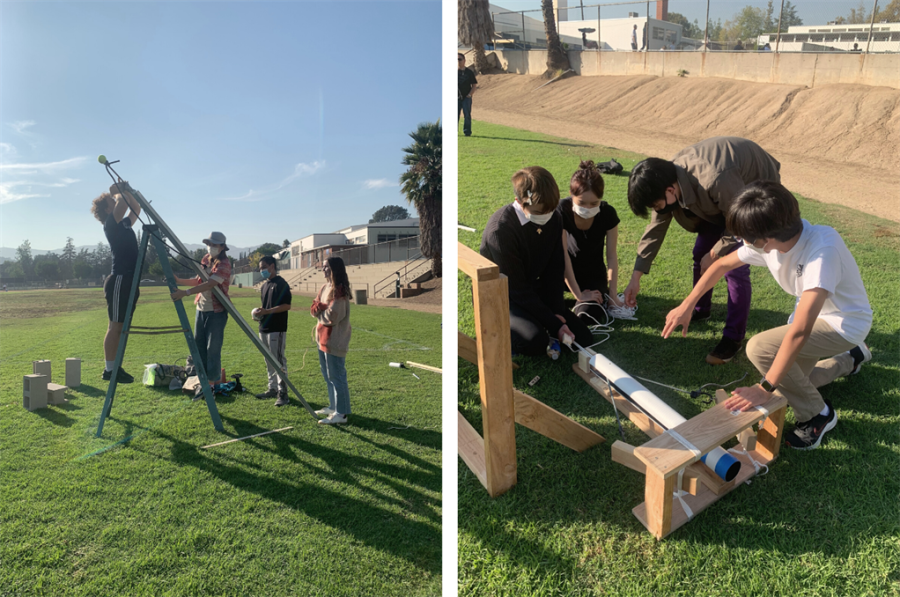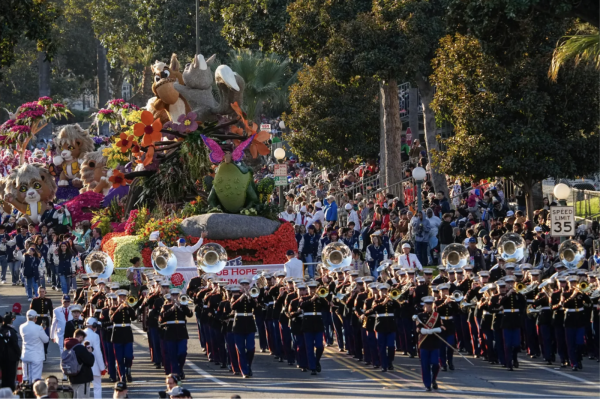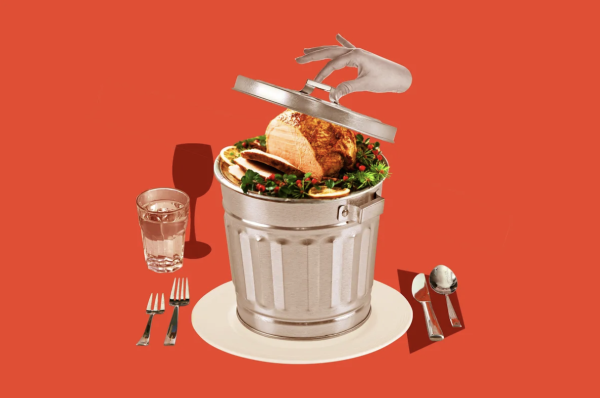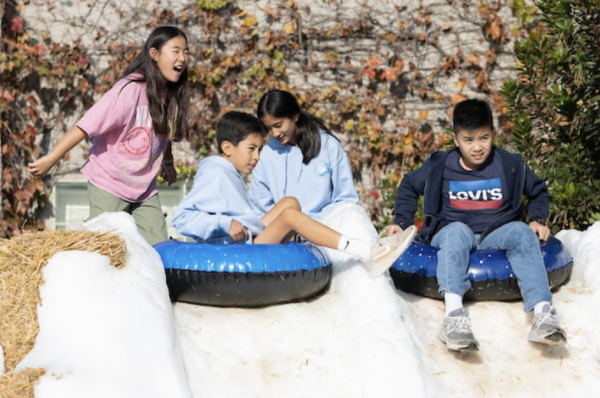JPL International Space Academy Challenges Prep Students
Photo courtesy Camila Ryder
Prep JPL Space Academy students test their launchers.
Select Flintridge Prep juniors and seniors engaged in a world of physics, engineering, programming, and stocks in a program affiliated with Jet Propulsion Laboratory (JPL) called the International Space Academy. This two-month program beginning in September encompassed the real-world experience of creating a company and producing and bringing a product to market. Students from Pasadena area high schools such as Flintridge Sacred Heart Academy, La Cañada High School, St. Francis, and Flintridge Prep had to apply to participate in the program. The twelve juniors and seniors from Prep that were selected were Victoria Barry ‘23, Charlotte Bax ‘23, David Chagoyen Neumann ‘22, Isaac Chung ‘22, Annabel Hou ‘22, Liam Klatsky ‘23, Sage Remulla ‘22, Alex Scoggins ‘23, John Stetson ‘22, Justin Sulivan-Pascual ‘23, Jiashu Wang ‘22, and Kendryek Wu ‘22. These students formed three teams of four people and met together with other schools every week on Fridays.
Alex Scoggins ‘23, one of the forty selected high schoolers in the program, explained that for the students, “the whole point was to build a launcher to launch your projectile to land in a hoop 20 ft away. And you want it to be as high as possible.” This required the use of physics, engineering, and a lot of trial and error.
The program began with lessons on creating a small company and brainstorming ideas for launchers. These launchers would be built and eventually brought to market. The students were taught how to give an elevator pitch and presentation on their plans and designs before they could start building. Scoggins said this is important “so that people want to invest in your company so that you do well.”
In addition to focusing on the construction of the launchers, teams had to keep track of others’ progress because there was a simulated stock market component. “Every team started out with a hundred dollars. And for every share that someone buys of your stock, it goes up a dollar. And then for every share that someone sells, it goes down a dollar,” Scoggins stated. “So each week you can buy as many shares as you want of any of the companies as long as you have the money for it. So you want to invest in the companies that you think are going to do well because their stock is going to get boosted if they launch well and it hits the hoop or it goes the highest.” Investing in the best performing group makes it more likely to get most of your money back. “Scoggins said, “it’s more of just like paying attention to which team is doing well, and also it gives you incentive to do well because then your stock price goes up.”
Each team member had a specific role. One person acted as the programmer, mainly focusing on the electronics, while another focused on the stock market. There was one person in charge of the communications and public relations, making sure to document the team’s progress and post photos and videos to Instagram. Finally, one person focused most of their time on the engineering aspect.
For the electronics, programmers on the teams coded Arduinos which are open-source electronics platforms and placed them into their selected projectiles. The Arduinos were used to measure the height of the projectiles when they were launched.
Every week, the students worked on building launchers and projectiles and continued to give presentations updating everyone on their progress. Based on these presentations, decisions would be made to buy or sell certain teams’ or companies’ stocks.
The Makerspace in the Bachmann Collaboration Building proved useful. The three Prep teams used saws, clamps, batteries, 3D printers and more during free periods and after school. Throughout the building process, Scoggins’ team stuck with one design and improved upon and troubleshooted it over time. “The first day Jiashu came up with, like, a very cool design and we’ve just been kind of running with it ever since,” said Scoggins, describing their “tripod launcher.” “Our first prototype crashed and burned. Not literally, but it broke, and it wasn’t super great, but just as of yesterday our second version is working,” Scoggins later said on November 9th. While this team was able to stick with one plan, another Prep team went through six different designs before settling on a crossbow, while another built a ballista.
The projectiles also had to be built. “We were originally going to use a design that was a triangle. It was very complicated, but now I think we’re just using a ball filled with sand because you have electronics that are going to calculate how high it goes. It’s whatever you need to protect your electronics and whatever you think is going to be as aerodynamic as possible and can go the highest,” Scoggins said.
Scoggins’ team’s biggest challenge was finding time to work. “I think that if people were going to do this next year because it’s really fun and I would recommend it, like, really time manage, like, know what you’re going to need to do and get it done because you don’t want to wait till the final week like we are because you will feel very stressed.” Scoggins described the process towards the end as a “mad dash to finish line” trying to build and refine the launcher.
Anywhere from three to fifteen hours per week of work was put in. Despite the long hours, the entire experience was stimulating. “I think it’s really interesting to, like, experience the process of trying to make something like this.” Scoggins has been planning on pursuing engineering in college and has never gone through such a unique process. Students had to ask themselves often “Where did it go wrong?” and “How do you fix it?” in order to move forward and correct their mistakes. Scoggins explained that the adults in the program didn’t really help them at all, “so it’s very cool because we’re having to do it all on our own.”
Overall, being in the program was both enjoyable and memorable. “Going to Home Depot is way more fun than it ever deserves to be. I mean I love just, like, working with the three guys on my team because I would never have been friends with them or at least actually talked to them if this hadn’t happened,” Scoggins reflects.
The teams had their final deadline on November 12th when they launched their projectiles. The International Space Academy will close out on Graduation Day on December 4th, and students will present their final stock price and a video documenting their experience.
Prep teams in the program
Ballistic: Isaac Chung ‘22, Annabel Hou ‘22, Sage Remulla ‘22, Kendryek Wu ‘22
PVC Pioneers: David Chagoyen Neumann ‘22, Alex Scoggins ‘23, John Stetson ‘22, Jiashu Wang ‘22
(Instagram: @pvc_pioneers)
9.81 Labs: Victoria Barry ‘23, Charlotte Bax ‘23, Liam Klatsky ‘23, Justin Sulivan-Pascual ‘23
(Instagram: @9.81labsjpl, Website: https://981labs.weebly.com/)
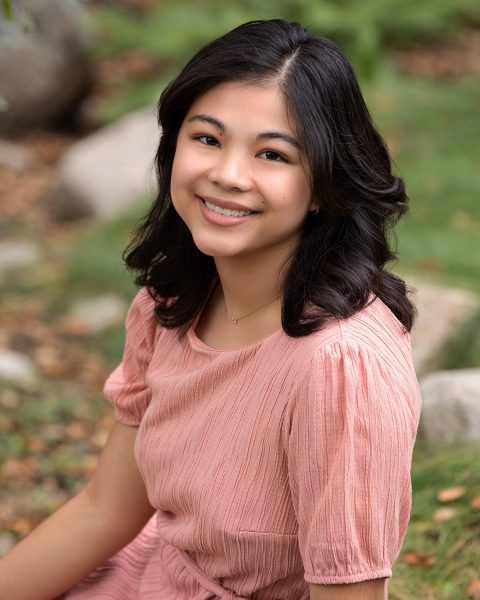
Grade: 12
Years on Staff: 4
Why are you writing for the Flintridge Press?
I enjoy writing and sharing important stories with the Prep community....

